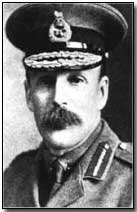Primary Documents - Sir Douglas Haig's "Backs to the Wall" Order, 11 April 1918
 Reproduced below is the
official German/Austro-Hungarian report into the British
capture
of Baghdad overseen by
Sir Frederick Maude on 11
March 1917.
Reproduced below is the
official German/Austro-Hungarian report into the British
capture
of Baghdad overseen by
Sir Frederick Maude on 11
March 1917.
The report, authored by Dr Gaston Bodart, stressed the inevitability of Britain's resolve to capture Baghdad following the British Army's earlier humiliation at Kut, where the British garrison - chiefly comprised of native Indian troops - eventually surrendered to Turkish forces at the end of April 1916, an outcome widely regarded as a heavy humiliation to British influence in the region.
Appointed by the Chief of the Imperial General Staff in London, Sir William Robertson, in the wake of the disaster at Kut, Maude's instructions were brief and somewhat unusual: effectively to hold his existing line and to do nothing. In particular Robertson was emphatic that Maude should not make demands for resources otherwise intended for the Western Front.
A cautious and consistent rather than spectacular commander, Maude nevertheless led his forces in a series of victories up the Tigris, beginning with the Second Battle of Kut and leading to the capture of Baghdad.
Ironically the British - and Robertson in London - found themselves a victim of their own success. Maude's continuing unbroken run of victories ensured that no scaling down of operations in Mesopotamia could feasibly be considered as Maude's reputation grew in the Muslim world.
Thus British operations were widened to stem threats from Turk forces on the Euphrates, Diyala and Tigris rivers. Following success at Baghdad, April 1917 saw Maude triumph again, at Samarrah, and he continued his offensive at Ramadi and Tikrit before calamity struck in early November 1917.
Struck down with cholera, probably via contaminated milk (rather than by poisoning as was speculated by some at the time), Maude died on 18 November 1917 and was replaced by General William Marshall.
Click here to read Maude's official despatch detailing operations leading to the capture of Baghdad. Click here to read the war reporter Edmund Candler's account of the reaction of the people of Baghdad to the city's fall.
Official Report by Gaston Bodart (for Germany and Austria-Hungary), on the Fall of Baghdad, March 1917
It was to be expected that after the capture of Townshend's army England would strain every nerve to retrieve her prestige.
Within the next seven months General Maude prepared with far greater care a much larger and better equipped expeditionary force. In the first place the rear lines of communication were improved, enlarged and made secure.
For this purpose Basra was selected as an adequate base of operations. In conformity with the principle advocated by Lord Kitchener in his Khartoum enterprise, field railroads were constructed between Basra and the operating army, and the flotilla on the Tigris was correspondingly increased and equipped.
General Maude methodically grappled with the situation at Kut, attacking that position from two sides, east and south. Under continued pressure of the gunboats, he captured Kut on February 23rd, 1917. The badly shaken Turkish army did not offer any further resistance of consequence to the English advance; the right wing of the English army being protected as far as Kengawer by the Russian group of General Baratoff.
The last Turkish position in the angle of the stream, formed by the junction of the Diala and the Tigris, was stormed, and it became necessary for the Turks to evacuate Baghdad. On March 11th the English entered the city of the Caliphs.
After a union with the Russians had been made by the occupation of Bakuba, and when Feludjah had been captured and the Euphrates made secure as far as Hit, the English continued their march toward Mosul. By a simultaneous advance of the principal columns along both banks of the Tigris and the victorious battle at Istabulat (April 21st, 1917) Samarra was reached, the two defeated Turkish corps being compelled to fall back to Mosul.
After a long pause, necessitated by the climatic conditions, Maude succeeded in nipping in the bud a design on the part of the Turks to deliver a blow against his left flank, in order to sever his rear communications.
The powerful Turkish position on the Euphrates near Ramadieh was successful attacked on September 28th with sufficient forces (a former attempt had failed), was surrounded by the cavalry and forced to surrender, whereby the Turkish commander Achmed Bey and 3,500 men were taken prisoners.
General Maude, the British commander-in-chief, died on November 19th in consequence of a camp malady, and was superseded by General Marshall. Under his command the English consolidated their control of Mesopotamia.
Source: Source Records of the Great War, Vol. V, ed. Charles F. Horne, National Alumni 1923
A 'Tour' was a period of front-line service.
- Did you know?
